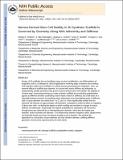| dc.contributor.author | Peyton, Shelly R. | |
| dc.contributor.author | Kalcioglu, Zeynep Ilke | |
| dc.contributor.author | Cohen, Joshua C. | |
| dc.contributor.author | Runkle, Anne P. | |
| dc.contributor.author | Van Vliet, Krystyn J | |
| dc.contributor.author | Lauffenburger, Douglas A | |
| dc.contributor.author | Griffith, Linda G | |
| dc.date.accessioned | 2012-12-18T16:43:46Z | |
| dc.date.available | 2012-12-18T16:43:46Z | |
| dc.date.issued | 2010-12 | |
| dc.date.submitted | 2010-11 | |
| dc.identifier.issn | 0006-3592 | |
| dc.identifier.uri | http://hdl.handle.net/1721.1/75767 | |
| dc.description | Author Manuscript 2012 May 21. | en_US |
| dc.description.abstract | Design of 3D scaffolds that can facilitate proper survival, proliferation, and differentiation of progenitor cells is a challenge for clinical applications involving large connective tissue defects. Cell migration within such scaffolds is a critical process governing tissue integration. Here, we examine effects of scaffold pore diameter, in concert with matrix stiffness and adhesivity, as independently tunable parameters that govern marrow-derived stem cell motility. We adopted an “inverse opal” processing technique to create synthetic scaffolds by crosslinking poly(ethylene glycol) at different densities (controlling matrix elastic moduli or stiffness) and small doses of a heterobifunctional monomer (controlling matrix adhesivity) around templating beads of different radii. As pore diameter was varied from 7 to 17 µm (i.e., from significantly smaller than the spherical cell diameter to approximately cell diameter), it displayed a profound effect on migration of these stem cells—including the degree to which motility was sensitive to changes in matrix stiffness and adhesivity. Surprisingly, the highest probability for substantive cell movement through pores was observed for an intermediate pore diameter, rather than the largest pore diameter, which exceeded cell diameter. The relationships between migration speed, displacement, and total path length were found to depend strongly on pore diameter. We attribute this dependence to convolution of pore diameter and void chamber diameter, yielding different geometric environments experienced by the cells within. Bioeng. 2011; 108:1181–1193 | en_US |
| dc.description.sponsorship | (National Institute of General Medical Sciences (U.S.) (NRSA Fellowship GM083472) | en_US |
| dc.description.sponsorship | National Institutes of Health (U.S.) (National Institute of General Medical Sciences (U.S.) Cell Migration Consortium Grant GM064346) | en_US |
| dc.description.sponsorship | National Science Foundation (U.S.) (CAREER CBET-0644846) | en_US |
| dc.language.iso | en_US | |
| dc.publisher | Wiley Blackwell | en_US |
| dc.relation.isversionof | http://dx.doi.org/10.1002/bit.23027 | en_US |
| dc.rights | Creative Commons Attribution-Noncommercial-Share Alike 3.0 | en_US |
| dc.rights.uri | http://creativecommons.org/licenses/by-nc-sa/3.0/ | en_US |
| dc.source | PMC | en_US |
| dc.title | Marrow-Derived Stem Cell Motility in 3D Synthetic Scaffold Is Governed by Geometry Along With Adhesivity and Stiffness | en_US |
| dc.type | Article | en_US |
| dc.identifier.citation | Peyton, Shelly R. et al. “Marrow-Derived Stem Cell Motility in 3D Synthetic Scaffold Is Governed by Geometry Along with Adhesivity and Stiffness.” Biotechnology and Bioengineering 108.5 (2011): 1181–1193. | en_US |
| dc.contributor.department | Massachusetts Institute of Technology. Center for Gynepathology Research | en_US |
| dc.contributor.department | Massachusetts Institute of Technology. Department of Biological Engineering | en_US |
| dc.contributor.department | Massachusetts Institute of Technology. Department of Biology | en_US |
| dc.contributor.department | Massachusetts Institute of Technology. Department of Chemical Engineering | en_US |
| dc.contributor.department | Massachusetts Institute of Technology. Department of Materials Science and Engineering | en_US |
| dc.contributor.department | Massachusetts Institute of Technology. Department of Mechanical Engineering | en_US |
| dc.contributor.mitauthor | Peyton, Shelly R. | |
| dc.contributor.mitauthor | Kalcioglu, Zeynep Ilke | |
| dc.contributor.mitauthor | Cohen, Joshua C. | |
| dc.contributor.mitauthor | Runkle, Anne P. | |
| dc.contributor.mitauthor | Van Vliet, Krystyn J. | |
| dc.contributor.mitauthor | Lauffenburger, Douglas A. | |
| dc.contributor.mitauthor | Griffith, Linda G. | |
| dc.relation.journal | Biotechnology and Bioengineering | en_US |
| dc.eprint.version | Author's final manuscript | en_US |
| dc.type.uri | http://purl.org/eprint/type/JournalArticle | en_US |
| eprint.status | http://purl.org/eprint/status/PeerReviewed | en_US |
| dspace.orderedauthors | Peyton, Shelly R.; Kalcioglu, Z. Ilke; Cohen, Joshua C.; Runkle, Anne P.; Van Vliet, Krystyn J.; Lauffenburger, Douglas A.; Griffith, Linda G. | en |
| dc.identifier.orcid | https://orcid.org/0000-0001-5735-0560 | |
| dc.identifier.orcid | https://orcid.org/0000-0002-1801-5548 | |
| mit.license | OPEN_ACCESS_POLICY | en_US |
| mit.metadata.status | Complete | |
